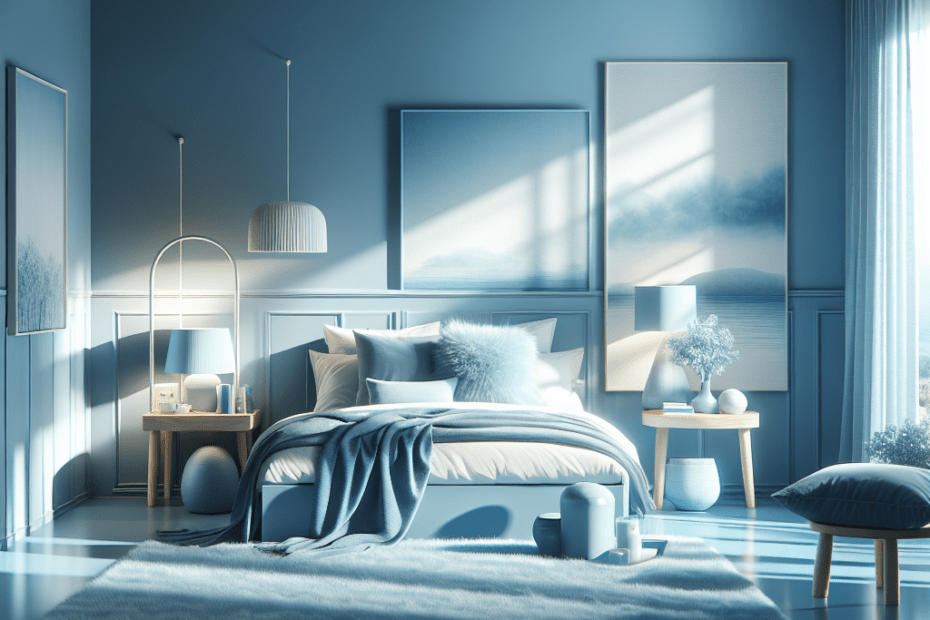Creating a Calm and Serene Bedroom with Blue Hues
When designing their homes, many people aim to create a peaceful sanctuary within their bedroom. The choice of color in a bedroom plays a significant role in establishing a serene environment. Many have found that blue hues, with their calming properties, are ideal for achieving this tranquil atmosphere.
Studies have shown that the color blue can reduce stress and anxiety levels. According to a study published by the University of Sussex, blue shades increase feelings of calmness by 23% more than other colors (source: University of Sussex). This makes blue the perfect choice for a soothing space encouraging relaxation and restful sleep.
Benefits of a Serene Bedroom with Blue Hues
A serene bedroom with blue hues offers numerous benefits. Not only do blue tones foster a calming environment conducive to sleep, but they also enhance mental clarity and boost mood. This is due to blue’s association with calm skies and tranquil seas, promoting a sense of stability and harmony.
Choosing the Right Shade of Blue
Not all blues are the same when it comes to creating a serene bedroom. Some shades to consider include:
- Pale Blue: Soft and airy, this shade helps create a light and open feel.
- Sky Blue: Reminiscent of cloudless sky days, this hue inspires tranquility.
- Midnight Blue: Offers depth and warmth, encouraging relaxation and peaceful sleep.
Refer to the table below for some blue shades and their specific calming effects:
| Shade | Calming Effect |
|---|---|
| Pale Blue | Light and spacious, reduces anxiety. |
| Sky Blue | Encourages peace and mental clarity. |
| Midnight Blue | Promotes deep relaxation and sleep. |
Incorporating Blue Hues into Your Bedroom
Integrating blue hues into their bedroom involves more than just painting the walls. Here are some innovative ideas to infuse calming blue tones throughout the space:
- Bedding and Textiles: Choose bed linens, pillows, and throws in various shades of blue to complement the decor.
- Accent Walls: Use blue for an accent wall to add depth without overwhelming the room.
- Decor and Accessories: Incorporate blue through artwork, vases, and lamps.
The Science Behind Blue’s Calming Effect
Color psychology reveals that blue has a profoundly calming effect on humans. Experts suggest that blue is linked to the production of neurotransmitters that promote relaxation, like serotonin, especially in calming environments such as bedrooms. Additionally, the cold temperature association of blue helps lower heart rates and promotes a soothing atmosphere.
Additional Tips for a Calm Bedroom
Beyond blue hues, they should consider several additional factors when creating a serene bedroom:
- Natural Light: Maximize the amount of natural light to enhance the calming effect of blue hues.
- Clutter-Free Space: Maintain organization to promote peace and relaxation.
- Essential Oils: Use calming scents, such as lavender, to complement the serene blue tones.
Key Takeaways
- Blue hues increase feelings of calmness by 23% more than other colors, creating a serene bedroom atmosphere.
- Different shades of blue, from pale to midnight, offer unique calming effects suitable for any bedroom style.
- Incorporating blue through textiles, decor, and accent walls can enhance the tranquil environment.
- The science of color psychology supports blue’s calming effects by promoting relaxation and reducing stress.
Frequently Asked Questions (FAQ)
- Q: What shade of blue is best for a relaxing bedroom?
A: Pale blue and sky blue are often recommended for their calming and airy effects.
- Q: Can I mix blue with other colors in my bedroom?
A: Yes, mixing soft neutrals like white and beige can complement blue hues and maintain serenity.
- Q: How can blue lighting affect mood in a bedroom?
A: Soft blue lighting can enhance relaxation and promote a restful environment.
- Q: Are blue hues suitable for small bedrooms?
A: Yes, light blues can make small spaces appear larger and more open.
- Q: What other elements can complement blue in a serene bedroom?
A: Natural materials like wood, and textures like linen, can add warmth and harmony when paired with blue.
